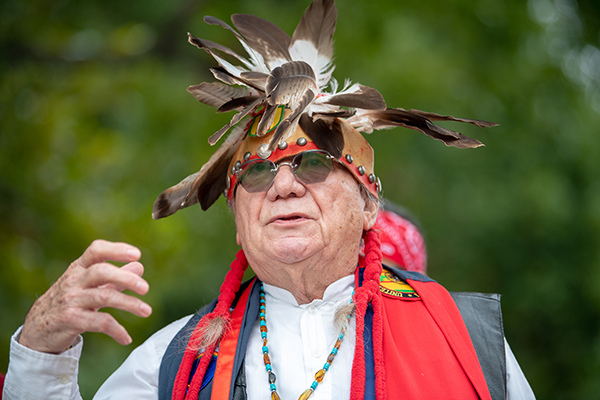Return of Indigenous remains moves forward after over a year after protests
November 10, 2021
Editor’s Note: This story is published in collaboration with the Moody Writing Support Program.
One year after the push for UT to return Indigenous remains it received from excavation sites, a plan to have them reburied is coming to light.
Fred Valdez, executive director of the Texas Archeological Research Laboratory, which currently holds the remains, said he has developed a plan for an Indigenous cemetery to be the final resting place for all “culturally unidentifiable” Indigenous remains held by UT, pending the approval of the state and federal governments. This comes nearly five years since the Miakan-Garza Band began the fight to recover their ancestors’ remains for reburial.
The proposed Indigenous cemetery will hold all of the culturally unidentifiable remains found in over 50 Texas counties, which are currently stored in the laboratory. Valdez will submit a finalized plan to the University by early 2022. If approved, the plan will head to the state and federal government for final approval.
“My heart goes out to all of these different folks who are interested in this,” Valdez said. “Because I know everybody understands and wants for these human remains to be reburied, and I’m in complete agreement with them. And I’m trying to figure out and work a way to do that that is satisfactory to everybody involved.”
Dr. Mario Garza and María Rocha, Elders of the Miakan-Garza Band who have spearheaded these efforts, said they have had difficulty claiming the remains since archaeologists have said the remains are not clearly linked to one group. Because of this, UT must reach out to all potential descendants before returning the remains to anyone due to the Native American Graves Protection and Repatriation Act.
Valdez said in late 2020, some federally recognized tribes declined to approve the return of the remains to the Miakan-Garza Band, while some Tribes have claimed the remains belong to their own tribe.
Much of this conflict stems from some federally recognized groups not wanting to acknowledge non-federally recognized ones, such as the Miakan-Garza Band, Valdez said. The 83rd Texas Legislature recognized them as a Texas tribe in 2013, according to the Indigenous Cultures Institute.
“Every time we apply for human remains some federally recognized tribes always file an injunction or an objection to us getting the remains,” Garza said.
Garza did not specify which tribes blocked the return of remains. He said if the Miakan-Garza Band were to formally retrieve the remains, it would be easier for them to attain a federally-recognized status.
Some federally recognized tribes do not want the Miakan-Garza Band to receive federal status, Garza said, as there is a limited amount of government resources distributed among federally recognized tribes.
“The more Indians you have, the more you have to (divide up resources),” Garza said.
Valdez said he hopes his plan to build an Indigenous cemetery will satisfy all groups.
“When I realized the confrontations that exist between federally recognized and non-federally recognized (tribes), my thought was, ‘The best approach to all of this is simply to do what’s right,’” Valdez said.
The cemetery will be in the shape of Texas, Valdez said, and the laboratory will bury the remains in the approximate location of the Tribes’ original burial site.
Valdez said he has spoken with all the Indigenous groups involved, the Texas Historical Commission and other agencies who agree with his plan.
“Everyone is invited, federally recognized groups, non-federally recognized, anybody who wants to come, who sees these people as their ancestors, you’re welcome to come and say whatever prayers, rituals, ceremonies that you want to do,’” Valdez said.
Mario Ollincoyotl Ramirez, an alumnus of UT who participated in a protest in September 2020 for the remains to be returned, said he believes these efforts are a step in the right direction.
“I feel really proud of my community and of our elders because that’s a big movement, but it’s also not the end-all be-all,” Ramirez said. “As long as Indigenous peoples are within the conversation of what’s happening, that is the best thing, and those are just the steps towards returning land and land stewardship back to Indigenous peoples.”



